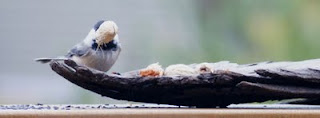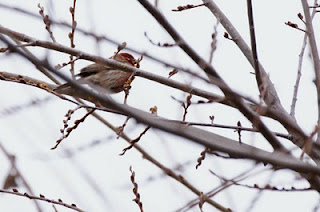
3/27/2010
peanut log
A gift! This log, with carefully drilled holes to hold nuts and positioned at the edge of our woods, is a new treat for the birds.

woodpecker tree
dogwood
3/13/2010
sprouts for lunch
3/04/2010
Boxelder breakfast
The grey squirrels nibble on the seed pods hanging in the Boxelder tree. When he leans out to where the branch is too thin to support his weight, the squirrel becomes a gymnast to reach breakfast.
3/01/2010
Woodpeckers on suet
 As the days get longer, some of the birds that were gregarious cooperative participants in the local "guild" of birds all winter are showing up at the feeders in pairs. Unlike in the very cold weather when they had to help each other find food and keep warm, now they are beginning to define territories.
As the days get longer, some of the birds that were gregarious cooperative participants in the local "guild" of birds all winter are showing up at the feeders in pairs. Unlike in the very cold weather when they had to help each other find food and keep warm, now they are beginning to define territories.The Downy woodpecker pair (above) and the larger Hairy woodpecker (below) will probably select their nest sites in the next three or four weeks. Meanwhile, they appreciate the suet feeders.

2/17/2010
bird tracks: snow angel
2/05/2010
1/07/2010
pileated woodpeckers

A pair of pileated woodpeckers (Dryocopus pileatus) live in our wild woods. They are very secretive so we have not located their nest or roost hole. Over the last few weeks we've seen them at the suet blocks every few days. Nearly 18 inches long, the male is big enough to tilt the "barn" feeder as he hangs on it. This afternoon, as the wind chills dipped, the female hung on a big tree and fluffed up her feathers to stay warm.

1/04/2010
elated chickadee
1/03/2010
12/18/2009
12/05/2009
winter guild
11/15/2009
11/08/2009
10/26/2009
the battle for black chokeberries
 A group of Eastern Bluebirds Sialia Sialis, darted in and out of the Black Chokeberry Aronia melanocarpa bushes. Surmising these bluebirds might be the two broods that fledged out of our nestbox this summer plus the adults, we smiled and watched as they flew around at the edge of the woods. Then, as the bluebirds moved off towards the cattails, a flock of Cedar Waxwings Bombycilla cedrorum appeared and settled in to savor the black leathery chokeberries. Their grey and buff coloring might help them go unnoticed, but their yellow tail-tips were bright accents among the burnished chokeberry leaves.
A group of Eastern Bluebirds Sialia Sialis, darted in and out of the Black Chokeberry Aronia melanocarpa bushes. Surmising these bluebirds might be the two broods that fledged out of our nestbox this summer plus the adults, we smiled and watched as they flew around at the edge of the woods. Then, as the bluebirds moved off towards the cattails, a flock of Cedar Waxwings Bombycilla cedrorum appeared and settled in to savor the black leathery chokeberries. Their grey and buff coloring might help them go unnoticed, but their yellow tail-tips were bright accents among the burnished chokeberry leaves.10/24/2009
the winter "guild"
 The birds are gathering into their winter "guild". Several of the woodpeckers are back again -- the Downy Woodpecker Picoides pubescens, the Hairy Woodpecker Picoides villosus, Red-bellied Woodpecker Melanerpes carolinus, and the big Pileated Woodpecker Dryocopus pileatus. This Red-bellied Woodpecker helped himself to sunflower and safflower seeds.
The birds are gathering into their winter "guild". Several of the woodpeckers are back again -- the Downy Woodpecker Picoides pubescens, the Hairy Woodpecker Picoides villosus, Red-bellied Woodpecker Melanerpes carolinus, and the big Pileated Woodpecker Dryocopus pileatus. This Red-bellied Woodpecker helped himself to sunflower and safflower seeds.10/23/2009
blue jays
10/22/2009
autumn woods
The woods and gardens are gorgeous! After several very cold nights, the leaves are changing to their autumn splendor. The black chokeberry bushes add a warm accent at the edge of the woods.


10/17/2009
peanuts
Peanuts (unsalted, in the shell) are a nice treat for many of the birds that gather into the winter guild here in the wild woods. The chickadees, ever curious, help themselves first whenever we put more peanuts out on the bark tray.



10/15/2009
early snow
9/22/2009
penstemon (maybe?)
 My gardens are surrounded by neighbors' flowery landscaped yards, one of which probably threw seeds to the wind for this result.
My gardens are surrounded by neighbors' flowery landscaped yards, one of which probably threw seeds to the wind for this result.Many of our favorite plants have struggled in this cool dry summer to develop their best blooms. But this beauty seems to have taken advantage of the situation to surprise us. Along the neighbors' fence, a few days ago I noticed some stalks of intense magenta blossoms among the cattails. Research has led me to think these are penstemons, although I am not sure of the exact species.
These plants seem to have self-seeded in an area that is wet enough to nurture their germination. Another welcome addition to the wild woods.
9/15/2009
bird bathing
The birds love the "bubbler" that continuously moves water in the crockery bowl that serves as one of our bird watering sites. This week the American Robins (Turdus migratorius) have been lining up and sometimes are rudely impatient as they take turns in the bowl. When this bird finished the vigorous part of her bath, she spent several minutes just relaxing in the water with her bottom on the bubbler.




9/01/2009
garden harvest
 The kitchen garden at the edge of the wild woods produces a precarious harvest of veggies when the grazing deer stay outside the rabbit fence. On most afternoons there are just enough tomatoes, summer squash, beans, snow peas, or leafy greens ripe for our small suppers.
The kitchen garden at the edge of the wild woods produces a precarious harvest of veggies when the grazing deer stay outside the rabbit fence. On most afternoons there are just enough tomatoes, summer squash, beans, snow peas, or leafy greens ripe for our small suppers.
Subscribe to:
Posts (Atom)















